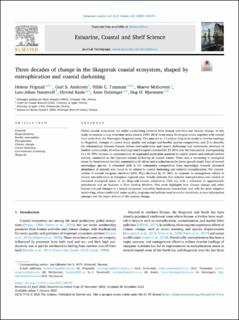Three decades of change in the Skagerrak coastal ecosystem, shaped by eutrophication and coastal darkening
Frigstad, Helene; Andersen, Guri Sogn; Trannum, Hilde Cecilie; Mcgovern, Maeve; Naustvoll, Lars Johan; Kaste, Øyvind; Deininger, Anne; Hjermann, Dag Øystein
Peer reviewed, Journal article
Published version

View/
Date
2023Metadata
Show full item recordCollections
Original version
Frigstad, H., Andersen, G. S., Trannum, H. C., Mcgovern, M., Naustvoll, L. J., Kaste, Ø., Deininger, A. & Hjermann, D. Ø. (2023). Three decades of change in the Skagerrak coastal ecosystem, shaped by eutrophication and coastal darkening. Estuarine, Coastal and Shelf Science, 283, 108193. https://doi.org/10.1016/j.ecss.2022.108193Abstract
Global coastal ecosystems are under accelerating pressure from human activities and climate change. In this study we explore a long-term time series (mostly 1990–2016) from major Norwegian rivers, together with coastal time series from the Norwegian Skagerrak coast. The aims are to: 1) analyse long-term trends in riverine loadings to Skagerrak, changes in coastal water quality and pelagic and benthic species composition, and 2) to describe the relationships between human drivers (eutrophication and coastal darkening) and community structure of benthic communities. Riverine discharge and transport increased by 23–85% over the time period, corresponding to a 40–78% increase in concentrations of suspended particulate material in coastal waters and reduced surface salinity, connected to the reported coastal darkening of coastal waters. There was a worsening in ecological status for hard-bottom benthic communities (0–30 m) and a reduction in the lower growth depth limit of several macroalgae species. A structural shift in the community composition from macroalgae towards increased abundance of animals was found to be related to coastal darkening and reduced eutrophication. The concentration of coastal inorganic nutrients (DIN, PO4) declined by 27–36%, in response to management efforts to reduce eutrophication in European regional seas. Results indicate that reduced eutrophication was related to increased ecological status of the deep soft-bottom community (350 m), with a reduction in opportunistic polychaetes and an increase in filter feeding bivalves. This work highlights how climate change and other human-induced changes in a boreal ecosystem intensifies land-ocean interactions, and calls for more adaptive monitoring, where traditional water quality programs and policies need to evolve iteratively as new information emerges and the major drivers of the systems change.
